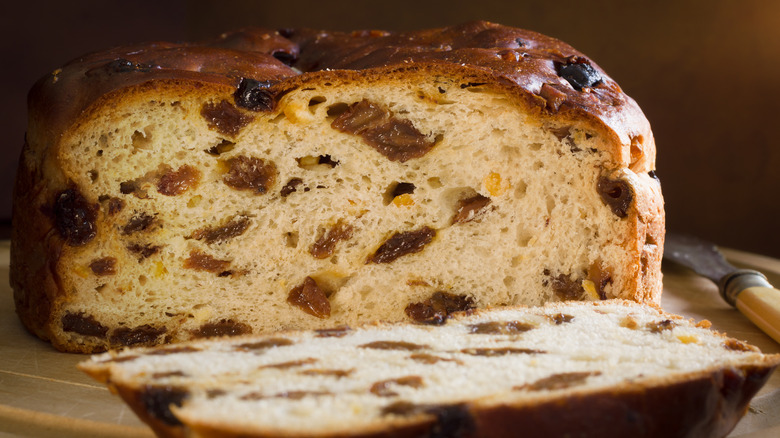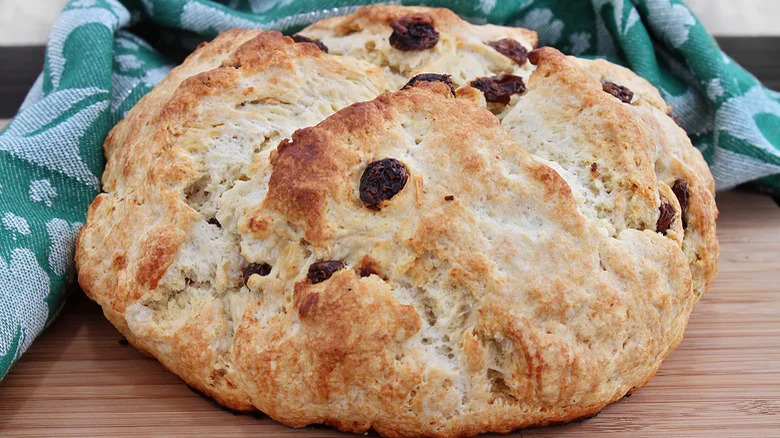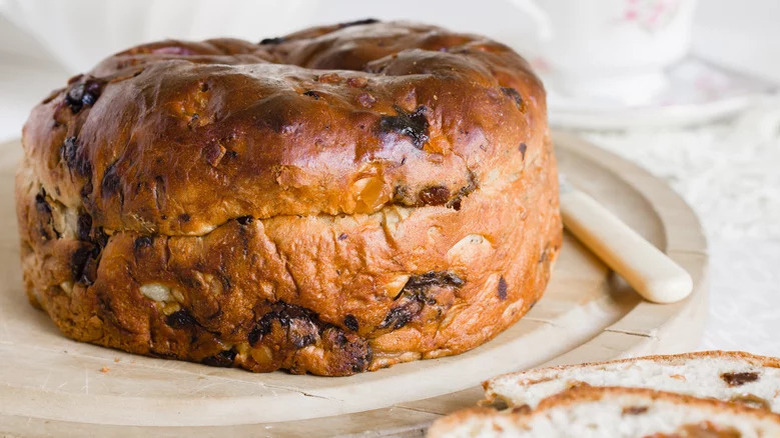The Difference Between Irish Soda Bread And Barmbrack
Barmbrack and Irish soda bread are rustic and hearty breads that are typically formed into round loaves and have their roots in Ireland. Both are associated with St. Patrick's Day celebrations across the globe. But, at least throughout Ireland, if not elsewhere as well, people enjoy barmbrack and Irish soda bread all year. Moreover, barmbrack and Irish soda bread are among the traditional Irish foods that many consider essential to understanding and appreciating Irish history and culture.
Looking at a slice of barmbrack, one might easily mistake it for a piece of Irish soda bread and vice versa. This is particularly true if the Irish soda bread you're accustomed to eating is raisin-flecked, as many of its modern recipes are (although that's not Irish soda bread's traditional form).
However, take a bite from each, and you'll instantly recognize the difference. Because of the raisins, one is chewy, bready, moist, and sweet, while the other is crumbly, cake-like, dry, and savory. Indeed, Irish soda bread and barmbrack are entirely distinct from one another. Each comes with its own set of ingredients and baking methods and has its unique origin story. Once you know the difference between barmbrack and Irish soda bread, we're certain there will be no mistaking them.
Irish soda bread is a crumblier bread that grew out of simple times
Irish soda bread is a historical triumph of frugality and simplicity. In its traditional form dating back to the Irish famines of the mid-19th century, it required no egg, sugar, yeast, kneading, or rising. In fact, traditional Irish soda bread only needed the rough mixing of four staple ingredients: flour, salt, baking soda, and soured milk.
Many of today's recipes call for buttermilk, but the earliest required nothing more than milk that had once seen fresher days. Many soda bread recipes outside of Ireland will be made using all-purpose wheat flour. However, traditional Irish soda bread uses Irish wholemeal flour, which is coarsely ground from soft wheat. Soft wheat grows more abundantly in Ireland than hard and has a lower protein content. It's not gluten-free, but its lower gluten profile and flecks of bran make for a crumblier baked good, precisely how Irish soda bread is meant to be.
Indeed, Irish soda bread is not yeast-risen. Instead, it rises from the effervescence that occurs when baking soda, a base, is mixed with buttermilk, an acid. That goes a long way toward explaining why Irish soda bread is baked with a cross carved into its top to guide the air as it's escaping without creating random fissures across the surface.
Barmbrack is a sweeter bread that has ties to Halloween
The traditional Irish bread known as barmbrack did not arise out of necessity, let alone famine. Rather, this sweet, tea-soaked, and yeast-risen bread studded with fruit was first served purely for fun and celebratory purposes on the occasion of the ancient Celtic festival of Samhain. Samhain is widely regarded as the forerunner to Halloween.
Traditional barmbrack is an English-language approximation of the Gaelic term "báirín breac," meaning "speckled loaf." It was initially made with raisins and a handful of inedible trinkets, including peas, sticks, pieces of cloth, beans, coins, and rings. Each trinket had a meaning assigned to it, and whichever landed in your slice was meant to foretell your future on Halloween. Today's barmbrack tends to eschew all trinkets except rings, which traditionally foretold an upcoming wedding.
Unlike soda-risen bread, barmbrack gets its rise from yeast. Therefore, it requires kneading and significant downtime for rising. Barmbrack also requires more prep than Irish soda bread because it begins with the soaking of raisins in hot tea or a splash of whiskey. In addition, barmbrack demands sturdy flour that can stand up to repeat risings because it relies on yeast, so you'll have to use hard flour instead of soft.


